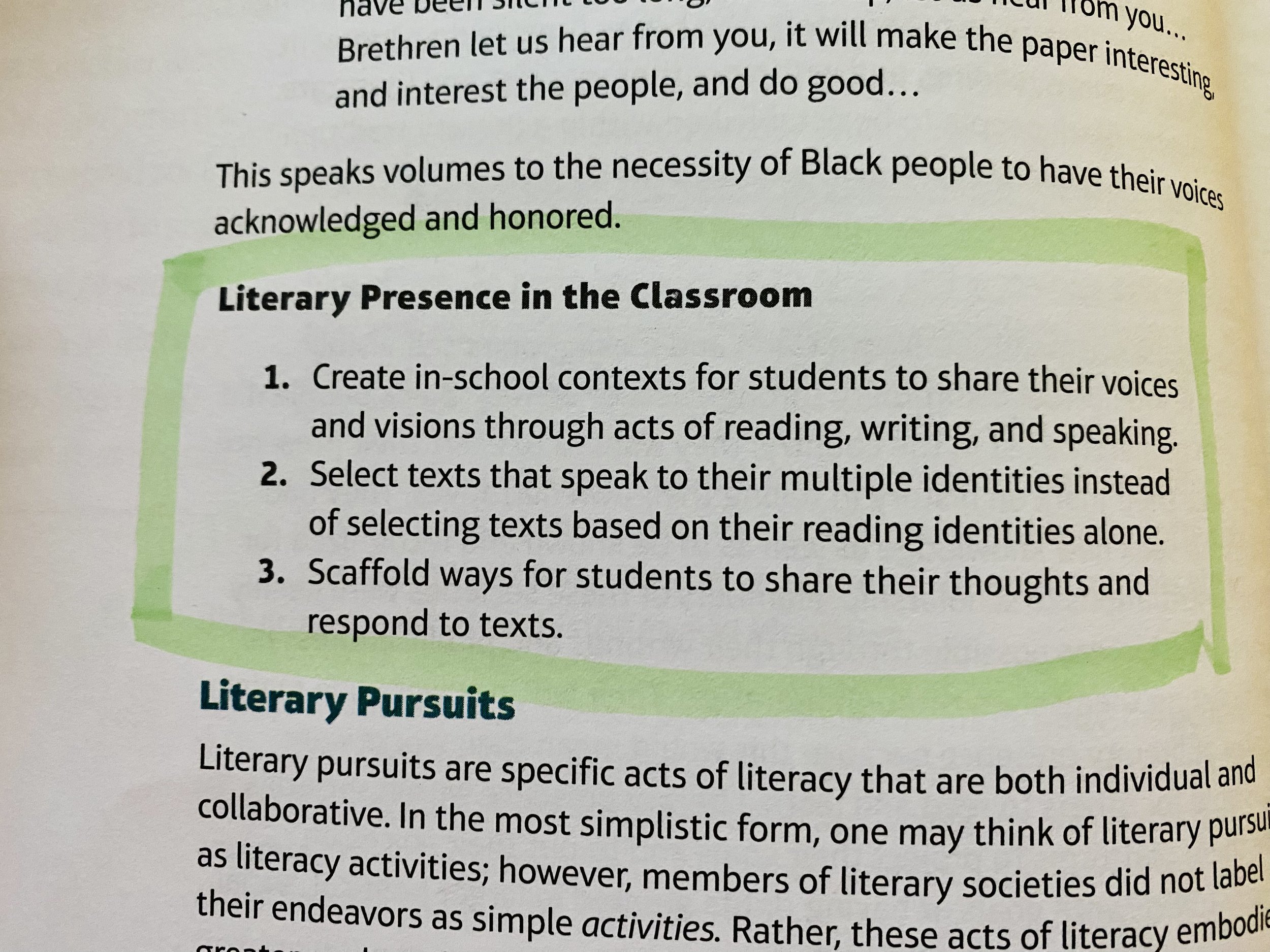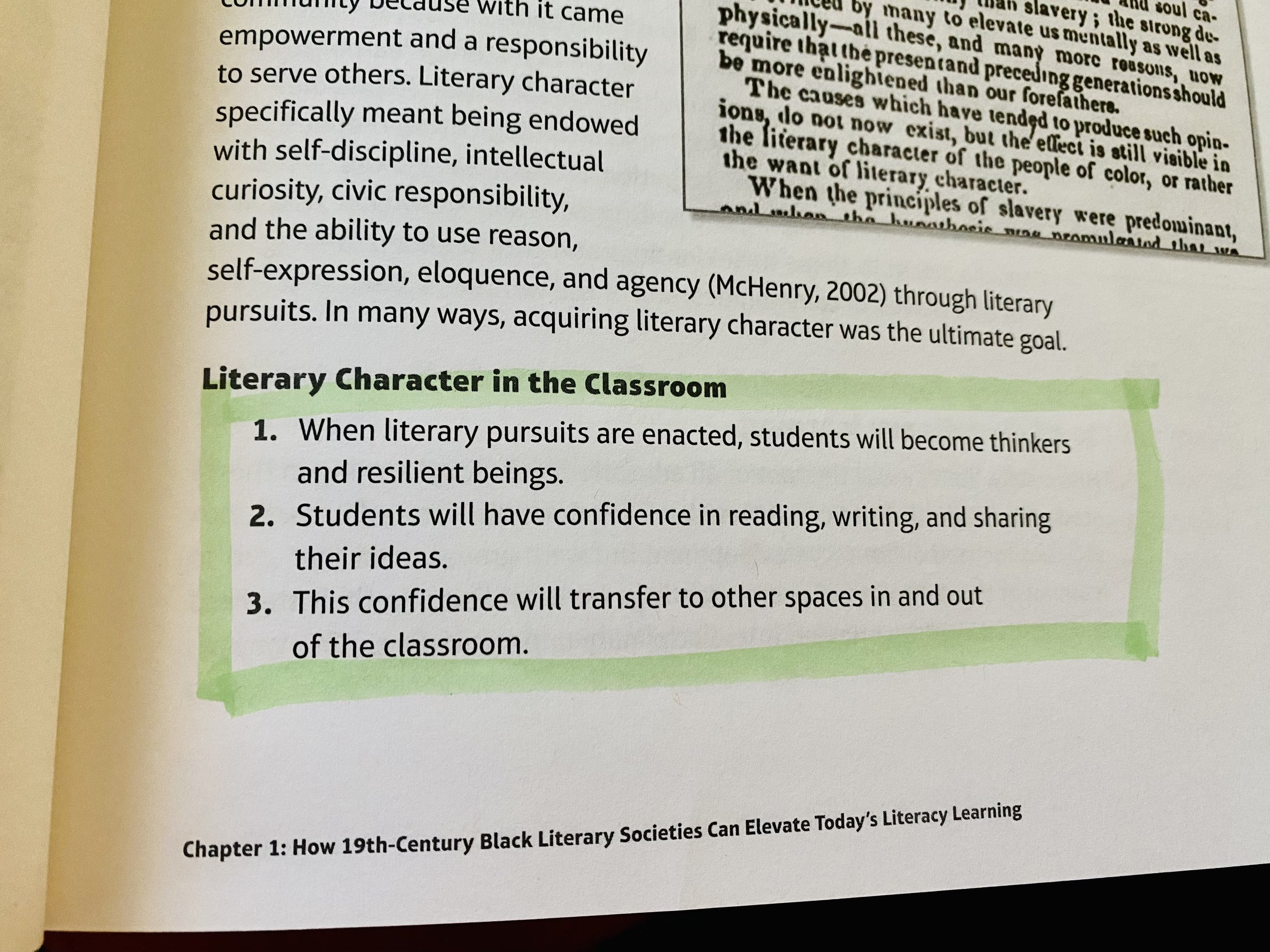Book Study Materials: Cultivating Genius: An Equity Framework for Culturally and Historically Responsive Literacy by Gholdy Muhammad
Book Study Materials: Cultivating Genius: An Equity Framework for Culturally and Historically Responsive Literacy by Gholdy Muhammad
Reading Schedule
September 1-10- pp. 8-61 (Introduction, Chapters 1 & 2)
September 11-17- pp. 63-99 (Chapters 3 & 4)
September 18-24- pp. 100-133 (Chapters 5 & 6)
September 25-30- pp. 135-171 (Chapters 7 & 8, Afterword)
Before Reading
Reading Notes & Discussion Questions
Look for these to be posted each week!
September 1-10- pp. 8-61 (Introduction, Chapters 1 & 2)
What do you know about black literary societies from the 1800’s?
“[Black literary societies] were organized as early as 1828 in cities within the northeast region of the United States. These societies existed in major cities such as Philadelphia, New York, and Boston” (9).
“In 1830, when many literary societies took shape, there were 319,599 ‘free’ Black people living in the northern region of the United States” (23).
Think about literacy as a basic human right.
“Literacy is not just about reading words on the page; it also carries some sort of action. In other words, reading and writing are transformative acts that improve self and society. In his speech, [James] Forten called attention to the importance of being able to read, to investigate text, and to teach that no one was created to wear chains of servitude and oppression. He professes that literacy is not just something one attains, but that it is, a human right” (9-10).
Teacher questions from pp. 10-11
What is missing from the ways we structure education today?
Why have school leaders and policymakers been unable to accelerate learning at a greater pace with the standards and pedagogies that have been traditionally taught in schools?
What is absent from curricular standards and frameworks?
What can we learn from history (particularly Black excellence) to refashion curriculum and instruction today?
Why are school leaders still mandating curricular frameworks that were not explicitly designed for students of color?
How does your genius as a teacher show up in your instruction?
“If teachers do not recognize their own genius, they. need to be striving each day for it. Mediocrity is not an option” (15).
How do imagination and reason show up as an expression of literacy in your content area? How do you support that literacy is a tool for protection and “fighting back?”
“…literacy serves as a form of protection in this world and is rightly guided by both imagination and reason-two constructs that are often dichotomous, especially in current public education. While imagination is praised and cultivated in early grades, I often find it diminished in middle and secondary schools. Finally, the writer ends with stating that literary societies will be central for the hopes of Black people” (19).
What responsibilities do you have as a teacher? What knowledge is necessary to share with your students?
”If one person, for example, acquired knowledge, it was then his or her responsibility to pass it on to others to create a flame-like effect. To keep knowledge to one’s self was seen as a selfish act, and each person therefore was responsible to elevate others through education in the immediate and larger community” (26).
Look over the following talking points for the three themes of Black literacy development. How do each of these areas show up in your classroom?
“As I read historical documents, three themes emerged of Black literacy development. These are literary presence, literary pursuits, and literary character” (27).
What is your definition of culturally responsive education?
“Ladson-Billings named and described the type of education African American students deserved. She defined culturally relevant education as a ‘theoretical model that not only addresses student achievement, but also helps students to accept and affirm their cultural identity while developing critical perspectives that challenge inequities that schools (and other institutions) perpetuate” (39).
How do we label our students? What impact does this labeling have on students? on the system of education?
There is a lot of literature covering the idea of labeling our students as "struggling readers." Gholdy Muhammad in Cultivating Genius: An Equity Framework for Culturally and Historically Responsive Literacy references the work of Johnson, D'Andrea Montalbano & Kirkland (2017) when she speaks about deficit language: "These labels connect to naming youth as "nonreaders" or "struggling readers"...the creation and assignment of such labels separates students into those who are alienated from their identities and those alienated from education as unuseful, unproductive, or likely unsuccessful, and they are further told messages of inadequacy and undesirability in media and society. This speaks to the harmful consequences of such labels for youth and their lives" (41). I say all this to say that labels are everywhere in your future school and classroom. Students will be labeled as advanced, struggling, and so on in terms of academics. Students will be labeled as behavior problems, tier 2, tier 3, and so on in terms of social interaction. Labels are unavoidable. Therefore, knowing that we will encounter them in the future, what will be your approach regarding labeling your students?
What are your thoughts about teaching in a state of transition? What would resolve this transition for all of our students?
“From the times that Black people were stolen away into slavery until today, we have been in transition. Transition typically signifies change, development, and transformation. Transitions are challenging, and diverse people have always lived in a transitional state due to the social environment and the times that have not always been kind and fair. We have had to resist and live in a constant state of resistance or transition” (55).
Related Videos
TED Talk mentioned on p. 21
September 11-17- pp. 63-99 (Chapters 3 & 4)
When considering identity work in your classroom, Gholdy Muhammad urges us to consider: “who we are, who others say we are (in both positive and negative ways), and whom we desire to be” (67). How often at the beginning of each school year, do we ask these questions of our students past “tell me about yourself?”
How do we connect our students to their histories as readers?
“For example, if a Black boy explained he is not a reader, I would help him connect to his lineage and heritage as a Black male. I would tell him that he came from generations of readers and thinkers and that reading is in his blood. In fact, African American literary societies were first developed by young Black males in 1828” (70).
Do you ask about the histories behind student names?
“Names are not just names. It is typically through our names that we are first introduced to the world. And as Ralph Ellison pointed out, our names are a gift from others and must be made our own” (75).
Factoring in student choice is huge for teachers of writing. Gholdy Muhammad reminds us to ask our students about the “urgency of your pen.”
How do we incorporate student choice into writing projects?
“What issues are most urgent of your pen? This question calls on students to think about their identities and communities and determine those social issues that are most in need of change or improvement. When I ask this question of youth, they develop a list of issues that need more attention or revision” (91).
Read more >>
A Complete Guide on How to Do a Class Research Project Focused on Activism
September 18-24- pp. 100-133 (Chapters 5 & 6)
How does standardized testing serve as a gatekeeper in your building or district?
“These tests still reflect the test creators’ ‘white bias’ and feature prompts that bear little resemblance to the lives of children who are underserved in schools. This explains why certain youth do not perform well on these high-stakes assessments -so named because they serve as gatekeepers. Youth may be labeled, shaped, and controlled by one test score” (106-107).
Revisit the lists on pp. 108-109. In what ways do we cultivate intellect in our classrooms and buildings?
How would you answer the opposition to critical race theory that is currently flooding news media? How would you answer a parent who is emailing you?
“Criticality helps teachers understand and explain inequities in education and is a step toward teaching anti-oppression, something that may not be in the forefront of teachers’ minds as they are encouraged to focus on test prep, college and career readiness, or skills-centered instruction. These elements of education alone can be very damaging for youth, especially for Black youth who are often told that they aren’t good enough and are treated violently in their own communities” (117).
Check out the preamble lesson on pp. 127-128. How could this work across subject areas? How could this work at the beginning of a school year to get to know students?
“As teachers start the school year, they can ask students to collectively compose their classroom community manifesto or statement that speaks to the purpose and power of their engagement in mathematics, science, social studies, or writing. This statement is then read every day in unison (standing) to start and conclude the class” (128).
September 25-30- pp. 135-171 (Chapters 7 & 8, Afterword)
Reflect on your curriculum, your classroom library, and the materials available to your students. Refer to the list of items on p.139 and record observations.
evaluate your own classroom library.
Use the Lee & Low Books classroom library questionnaire. What areas can you address first? How do you go about getting more resources into your classroom? (DonorsChoose, donations, etc)
Create an assignment where students make their textual lineage or text family tree. Use my template if you need a place to start.
Text Family Tree Assignment: Find out what books and media are important to each student. Explain that reading and literacy is more than books and reading.
Make a copy of my Jamboard assignment here.
“I like to think of textual lineages as my ‘family tree of books and other texts.’ We all remember certain movies, books, poetry, works of art, and other texts that have shaped our thinking and understanding of the world and ourselves. I think teachers should start with their own textual lineages of meaningful and significant literature and then look at their lists to see how much they have impacted their teaching of their content area” (147).
Review your next unit of study. Create a list of layered texts to add to the unit to help build student understanding and provide access to diverse texts.
Layered Texts Examples:
6th Grade: p. 162
8th Grade: p. 163
10th-12th Grade World Literature: p. 164
11th Grade: p. 165



















Grab your copy of Ratchetdemic: Reimagining Academic Success by Dr. Christopher Emdin.